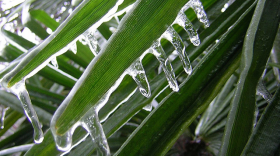Blue-green algae levels are so high in the eastern Caloosahatchee River that the Florida Department of Health in Lee County issued a special public health alert prior to Memorial Day weekend that remains in effect.
Last month, four health advisories for the same harmful algae bloom were issued in or near the headwaters of the Peace River by the DOH in Polk County including one at Lake Hollingsworth, a popular waterskiing spot, where the agency advised against going in the water to do anything.
Lee and Polk counties are more than 100 miles apart, but the Caloosahatchee and Peace rivers empty into the Charlotte Harbor Estuary less than 20 miles apart, the Peace River into the northern end of the harbor, and the Caloosahatchee to its south portion of the estuary.
The Florida Department of Environmental Protection investigated several outbreaks of blue-green algae along the eastern side of Lake Okeechobee last month and deemed one a dangerous “high-severity bloom” and several others just below that.
The trifecta is stoking concerns already voiced by South Florida's water managers and environmental groups that this summer is going to bring a blue-green algae outbreak to the region that will rival 2018's monstrous bloom that fouled Southwest Florida waters for months.
In April, Gil Smart, executive director of the clean water nonprofit group VoteWater, said conditions in Lake Okeechobee were right for a “summer of slime.”
He still hopes he is wrong, but everything is shaping up to prove him right.
“The potential is there for a really, really bad summer because if you're already seeing this on the eastern portions of the Caloosahatchee,” Smart said. “I mean you know the conditions aren't gonna get any better, let’s put it that way.”
The Army Corps, the agency in charge of keeping the lake’s water levels in check for a new hurricane season, has been releasing about 2 billion gallons of water per day from Lake Okeechobee into the Caloosahatchee River for months.
“When we get water from the lake that has algae in it just has this tendency to explode once it hits the estuaries,” Smart said. “I don't see good things happening going forward.”
Hopelessly polluted
Lake Okeechobee is hopelessly polluted after a century’s worth of runoff from industrial agriculture and fertilizer use by residents along the Kissimmee River watershed north of the big lake that feeds into it. The nitrogen, phosphorus, and other chemicals are trapped in the muck beneath that lake – unless a big blow riles up everything.

In September, that big blow was thanks to Hurricane Ian, which moved slowly across the Watery Heart of the Everglades and caused whitecaps atop the lake and the layers of buried chemicals and water to mix below.
Residents along the Caloosahatchee River, too, fear releases of nutrient-rich water from Lake Okeechobee because they say in the past – especially five years ago, the summer after Hurricane Irma followed a path similar to Ian’s - the releases are responsible for blooms of blue-green algae that leave a slimy green coating on everything it touches.
Scientists say the blooms have public health impacts, and any influx of freshwater with excess nutrients hurts marine life and stunts seagrass growth or kills meadows outright.
‘Shouldn’t be normal'
The environmental nonprofit Friends of the Everglades also weighed in last month about the blue-green algae threat emanating from Lake Okeechobee this summer.
The group posted an advisory on its website about water managers “predicting an intense summer algae bloom on Lake Okeechobee due to heavy rainfall from Hurricane Ian that caused the lake to rise, delivering pollution-loaded runoff from the surrounding areas and killing submerged aquatic vegetation.
“It shouldn’t be normal that Floridians fear the threat of toxic algae in the summer months, just as we nervously watch for the approach of hurricanes — but recent, repeated history has given us good reason to be wary.”
Solution not easy
Col. James Booth is the commander of the Army Corps region that includes Florida, and earlier this year he was frank about the need to lower Lake O’s level despite the water doing damage downstream.
“We expect an increased risk of algal blooms next summer due to the hurricanes,” Booth said. “During the height of hurricane emergency response efforts, our decisions were easy to reduce immediate impacts.
“Now, the question of how to manage all the water in Lake Okeechobee is upon us, and the solution is not an easy one.”
Environmental reporting for WGCU is funded in part by VoLo Foundation, a non-profit with a mission to accelerate change and global impact by supporting science-based climate solutions, enhancing education, and improving health.
Sign up for WGCU's monthly environmental newsletter, the Green Flash, today.
WGCU is your trusted source for news and information in Southwest Florida. We are a nonprofit public service, and your support is more critical than ever. Keep public media strong and donate now. Thank you.








